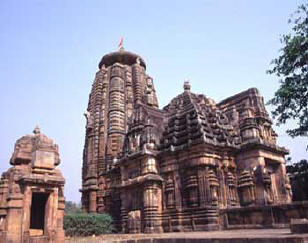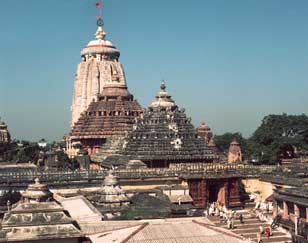Holy Destinations of India
Bhubaneswar
Bhubaneswar, the capital of Orissa, is also popularly known as the "Temple City of India". Being the seat of Tribhubaneswar or 'Lord Lingaraj', Bhubaneswar is an important Hindu pilgrimage centre. Hundreds of temples dot the landscape of the Old Town, which once boasted of more than 2000 temples. Bhubaneswar is the place where temple building activities of Orissan style flowered from its very inception to its fullest culmination extending over a period of over one thousand years.
The new Bhubaneswar with its modern buildings and extensive infrastructure perfectly complements its historic surroundings. With facilities to cater to every type of visitor, Bhubaneswar makes an ideal tourist destination.
|
Photos of Bhubaneswar |
|
|
|
|
History of Bhubaneswar
The history of Bhubaneswar and its environs, as the several archaeological
finds from the dawn to historical period to the end of Hindu rule, testify
goes back much earlier than the 7th to 13th centuries. Its sanctity as
Ekamrakshetra led rulers to embellish the area with grandeur temples
actuated by the hope of an eternal abode in heaven. The Bhubaneswar area
first appears in history during the 4th century BC. The fortified city of
Sisupalgarh, 5 km northeast of Dhauli and 2.5 km southeast of Bhubaneswar
was the site of Kalinga Nagar, the Capital of the Chedi (Mahameghavahan)
Kings. Excavations here revealed that this Fort had a well developed civil
and military architecture, all through the beginning of the 3rd century BC
to the middle of the 4th century AD. The archaeological remains at Dhauli,
and hills of Udayagiri and Khandagiri give evidence of both Jain and
Buddhist settlements around Bhubaneswar in the first two centuries BC, also
see for Dhauli on pg. 41, Udayagiri and Khandagiripg. 46. The waning of
Buddhism and vanishing of Jainism with the growth of Saiva Pasupata Sect,
the second century BC saw Brahmanism as the dominant religion underthe
successive dynasties that ruled Orissa-the Shailodbhava and the Bhaumakaras
in the 12-13th centuries. The temple building reached the zenith of its
glory between 7th and 12th centuries when thousands of sandstone temples
were erected around the Bindu Sagar, earning it the title 'The city of
Temples'. The period under the Gangas saw emergence of Vaishna-vism to
prominence. The perfect symphony between its architecture and sculpture, the
mastery carvings and the grand repertoire of its motifs make these temples
unique. In the 15th century, the Mughals eventually raided the city and
razed all but a few of the temples. After independence, Bhubaneswar was
declared the new Capital replacing Cuttack.
Best time to visit: Bhubaneswar can be visited round the year, but
the ideal time, especially for visitors from colder climes, would be from
October to March.
Stay in Bhubaneswar : With numerous hotels as well as the Orissa Tourism Development Corporation's Panthanivas, Bhubaneswar is well equipped to accommodate every type of visitor.
Handicrafts of the Region: Silver filigree, Stone and Wood carving, Patta paintings, Tie and Dye textiles, bamboo basketry, brass and bell metal work, horn work, and many other famous handicrafts of Orissa can be selected as souvenirs from the local markets. Purchases can be made from Utkalika (run by the Department of Handicrafts) or at the many privately run shops.
Places to visit
Orissa State Museum - The museum at the top of Lewis Road, or near
Kalpana Square showcases some of Orissa's finer archaeological remains and
treasures displayed in various galleries. It has a magnificent collection of
various archaeological finds including some Buddhist and Jain sculptures,
copper plates, coins and donatives inscriptions from ancient and medieval
Kalinga. It boasts traditional and folk musical instruments, heavy jewellery,
ancient weapons, tools and some photographs. The highlight of the museum is
the rare palm leaf manuscripts and a collection of antique paintings. The
well equipped library of the museum has some valuable publications on
archaeology, architecture, history, anthropology, philosophy etc. Monday
closed.
Museum of Man - Also known as the Tribal Research Institute, located
near the CRP Square, has collection of tribal dresses, weapons and jewellery
representing more than 60 different tribal groups mostly concentrated in
southern parts of Orissa. Prototypes of the traditional style huts with
authentic murals decorating their walls attract a large number of visitors.
Sundays closed.
Pathani Samantha Planetarium - Named after the illustrious astronomer
of Orissa, the planetarium situated near the Acharya Vihar Square, features
programmes related to astronomy in a domed shaped air conditioned
auditorium. The sprawling 4 acre complex has well manicured garden around
it.
Orissa Modern Art Gallery - Set with the sole objective to promote
contemporary Orissan art, the Gallery at Surya Nagar has an array of work in
oil and water, sculptures, serigraphy, etching, lithography, wood carvings
showing myriad aspects of life.
Ekamra Haat - A showcase of Orissa's art, craft, culture and cuisine,
set amidst lush green environ, Ekamra Haat, on a 5 acre plot is managed by
IDCO, on behalf of the State government. The architectural design and
ambience of Haat matches the activities carried out there. The shops selling
ethnic produce not only promote the traditional craft but provide a direct
market access to the local artisans and weavers. The infra-structure and
facilities also include an open-air theatre, lily pond with water fountain,
food stalls, artisan rest rooms and info centre.
Other Tourist Attractions of Bhubaneshwar include:
-
BDA Nicco Park and Resorts at Madhusudan Nagar, spread over about 25 acres of land is a family entertainment park with different rides, games and a lighted water fountain;
-
The Rabindra Mandap Auditorium, a centre for regular music and drama events;
-
Ekamrakanan or Government Regional Plant Resource Centre in Nayapalli has a large rose garden, a lake and a cactus garden;
-
Regional Museum of Natural History, near the Acharya Vihar Square, consists of models and photography to create awareness about conservation of natural heritage and our rich biodiversity; Regional Science Centre, near Acharya Vihar Square , has four halls consisting exhibits to popularise science and technology especially among school children;
-
Kalanagar on Khandagiri Road, display handicraft items like horn ware, brass casting, terra-cotta, silver figurines and sculptures and paintings.
Famous Temples in
Bhubaneshwar
Brahmeshwar Temple
Mukteswar Temple
Parasurameswar Temple
Rajarani Temple
Vaital Deul Temple
How to reach
Bhubaneshwar is well connected through Rail, Road and Air Network.
Information on How To Reach Bhubaneshwar.
Reach Bhubaneshwar through Air : Bhubaneshwar is well linked by air
to Delhi, Chennai, Varanasi, Nagpur, Calcutta, and Vishakhapatnam on daily
basis flights by Indian Airlines. The Biju Patnaik Airport at Bhubaneswar
provides daily connections to Kolkata and Delhi. Indian, Jet Airways, Air
Sahara and Air Decan are the domestic airlines also flying to Chennai,
Visakhapatnam, Mumbai and Hyderabad. The airport is 4 km from the town
centre.
Rail: Superfast trains connect Bhubaneswar to major cities of India.
A major railhead on the East Coast (E Co) Railway, it has fast and super
fast train links to Kolkata, Guwahati, Delhi, Chennai, Hyderabad, Bangalore,
Thiruvananthapuram, Mumbai, Ahmedabad and other important centres of the
country as well as within the state. The station is located in the centre of
town.
Reach Bhubaneshwar by Bus / Road: Bhubaneswar is well linked to the
rest of India by the national highways. The New Bus Stand in Bhubaneswar is
on NH5, at Baramunda, about 6 km from town centre.
The buses for Puri and Konark, more frequent for Puri, leave almost
every 15 minutes. Buses to Puri and Konark also depart from Kalpana Square,
at the top of Lewis Road. Volvo service from Puri to Kolkata (12 hrs) via
Bhubaneswar is also very convenient.

